Origin
The origin of the festival
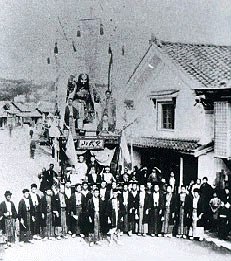
The festival began about 370 years ago, when the people of Esashi thanked God for the great catch of herring. The oldest dolls and Mizuhiki, which still remain in Esashi, belongs to the Parade float of Jinguyama, which were delivered by a doll wholesaler in Kyoto from 1754 to 1762.
Back calculation based on the dolls, date them back to about 250 years ago. However, this does not directly related with the inception of the festival.
The festival Parade floats have been decorated bit by bit over many years to the point of their lavish decorations as seen today.
Mikoshi (Portable shrine)

In the Togyosai Festival of Ubagamidaijingu Shrine, Parade floats are used to transfer Mikoshi (portable shrines carried on sholders). There are four Mikoshi, the oldest one was made in Osaka in 1694.
One of the highlights of the festival is at the end of the second and third days, the Mikoshi are placed into the Daijingu shrine one by one. This ceremony is called Shukuire.
The dyeing of festival colours.
People who moved to Esashi have always been regarded as spectators. However, those that were born and raised in Esashi are very enthusiastic about the festival. For them the festival is not mearly 3 days long, but more of a month long event. During this month the particpants are practicing the flute and drums as well as other preparations, which coinsides with being half a month before the summer holidays.
Festival season (1)
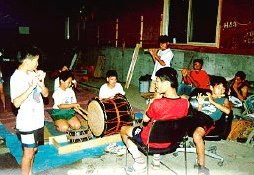
In mid-July, you can hear the sound of flutes and drums on the wind out of nowhere. At each practice place provided by each town community, elementary and junior high school students wearing shorts & T-shirts put their effort on practicing the music that is handed down to their Parade floats.
Practice continues after dinner, not to mention during the day, learning the music by watching the older children. There is still a nostalgic childhood society. Not to forget, they repeat the practice drum with a zabuton cushion even at home.
Practice of festival music (flute and drum).
Festival season (2)

Four or five days before the start of the event, in vacant lots around the town, tents are erected out of steel pipes and tarpaulin. The Parade floats are then extracted from the garage where they have been placed in storage since the previous years festival. The children clean and polish the Parade floats in between their music practices. It is normally this time that the festive mood begins to rise within the town both in children and in adults.
Children
For children that grow up in Esashi the festival enters their mind from an early age. Infants generally are in the Parade float house parapit and the sound of the drums and the flutes can act like a lullaby to infants especially when going around the town all day.
Parade
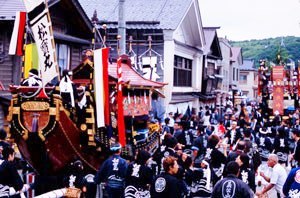
The night before the festival at Ubagamidajingu there is an entering of spirits parade. The Parade floats go around the alleys in the town and make greetings. This symbolises the long awaited coming of the festival, children pulling the ropes of the Parade floats and playing drums and flutes spreads happiness throughout Esashi.
In the main festival, on the first day a Parade float accopanied by a Mikoshi visits Shitamachi which is where the remaining old town meets the beach. On the second day they visit Uemachi which is centered around the downtown area.
Until the evening on both days, high-quality music and the cheerful voice of children continues. In the evening, the aspect of the festival changes suddenly. The Parade floats become dressed in lacquer and metal fittings and increase in their luxury with flaming and shining illuminations. The number of young pullers increases, and the movement of the Parade floats intensifies over time.
Highlight(1)
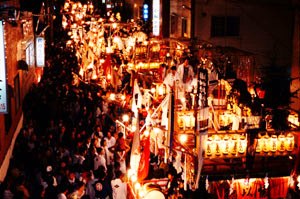
At 8:00pm on 10th August, along the old national highway in Atago-cho which has an old shopping district, 13 dazzling Parade floats with illuminations line up and continue the festival music.
The streets are filled with Parade floats, pullers, and sightseers. It is flooded with light, sound and people. The Parade floats are pulled by young people who are gaining momentum and heading to the shrine in order.
Shukuire (accommodate God)
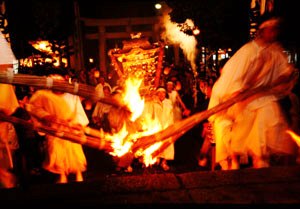
At 9:30pm on 10th August, Shukuire begins for three Mikoshi after going around Shitamachi.
First of all, eight people light a long broom-shaped torch which is bundled with Shino bamboo, face each other, and run up from the torii gate to the shrine as if sweeping the paved stone path with fire.
The three Mikoshi are placed into the shrine one by one. It seems that the torches lead them. Young men in white coats carry the Mikoshi, run quickly to the approach (road approaching a shrine), and run up the cobbles in front of the shrine which sways the Mikoshi. The will of God does not fit in once, so the first Mikoshi makes Shukuire at the seventh attempt then celebrations start in the shrine. The second Mikoshi makes it at the fifth attempt and the third Mikoshi makes it at the third attempt.
With the sparks scattering and the sweat from the young men, during this time the sightseers hold their breath and watch. When the third Mikoshi enters the shrine, you will hear cheers from the surroundings, and the celebration continues inside the shrine.
Highlight(2)
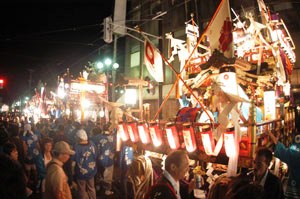
At 9:30pm on 11th August
the Togyosai Festival's climax happens between the intersection of Shinchicho and in front of Kenkoinarijinja Shrine. This area is filled with sightseers. Even if the sidewalks become less crowded, it is still difficult to move forward. A traffic officer will desperatly say"do not get off the road".
The young people are rushing in the street, the Parade floats start to be set at predetermined positions in order from the leading Parade float. This is the highlight of the steering of the Parade floats.
The Parade floats will be pushed from the rear on the pavement side and will face the front to the spectators.
Once all the Parade floats have gathered, hundreds of meters of the streets are filled with flaming swirls of light, the music of each Parade float and shouting. The excitement and joy rise up into the nights sky.
On the Parade floats, the young men who have taken their tops off hit the drums with brute force, high school students of "Sentori" are dancing at the top of the stall with a line-drawing stick. This will continue for about 2 hours, the festival music will continue at Tateyama, the largest and last showing of the Parade floats. The end of the festival will be announce during the festivities.
Festival music
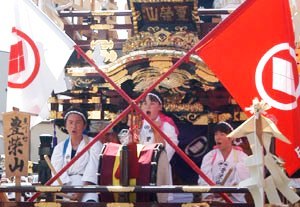
In 1845, it was reported that the donator of Shohomaru ship, who is an Omi Merchant, invited the Gion musicians from Kyoto to train local people. Although it has been somewhat arranged in history, its elegance and high-class are unique to Hokkaido. There are three pieces of music for each Parade float. They are: “Yukiyama” which is played during the parade, “Tateyama” in front of the shrine, and “Kaeriyama” when coming back. In total for 13 Parade floats, there are 39 pieces of music. It is said by those who participate in the festival that the sound of the flues and drums remain to their ears for a while, even after the 3 day festival has finished.
【Inquiries】
Sightseeing Section
Oiwake Sightseeing Department
Esashi Town Office
Address: 193-1, Aza Nakauta-cho, Esashi-cho, Hiyama-gun, Hokkaido
Postal code: 043-8560
TEL: +81-139-52-6716
FAX: +81-139-52-5666